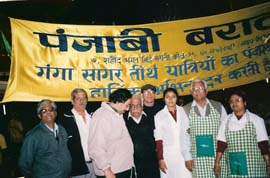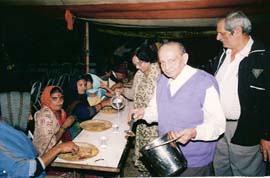|
Among Hindus the month of January brings great festivity. Besides being a very auspicious time Astrologically. The second week of January brings to me :
1. The Makar Sankranti - Transit of Sun from the sign Sagittarius to Capricorn.
2. The Ganga Sagar Mela
3. Lohri
4. Pongal
5. One of the Hindu New Year.
6. My daughter Hersheeta’s Birthday.
The Ganga Sagar Pilgrimage is one of the largest annual pilgrimages in India. About a million pilgrims come from all over, speaking different languages and belonging to diverse castes and creeds, for a sacred dip to wash away all their earthly sins, at this holy confluence.
It is held near the confluence of the Ganga and the Bay of Bengal. They come for the holy dip on Makar Sankranti and offer homage at the Kapilmuni Temple nearby.
Makar Sankranti is celebrated in the last day of the Bengali month of Poush.
In Bengal, this day is one of the most auspicious times of the year.
According to the legend, in the Satya Yug lived a king named Sagar. He performed a holy yagna, the Ashwamedh yagna. The symbol of his power, the Ashwa or the horse, was lost during this ceremony and Sagar's 60,000 sons traveled far and wide to find it
 Finally, they found the horse near the ashram of the great sage Kapil and blamed him for stealing their horse. Insulted and enraged, the sage turned the princes into ashes. On hearing this, King Sagar went to the sage and begged for his mercy. After many entreaties, the sage came around. He told the king that his sons would gain enlightenment if their ashes were washed by the holy water of the Ganges. Finally, they found the horse near the ashram of the great sage Kapil and blamed him for stealing their horse. Insulted and enraged, the sage turned the princes into ashes. On hearing this, King Sagar went to the sage and begged for his mercy. After many entreaties, the sage came around. He told the king that his sons would gain enlightenment if their ashes were washed by the holy water of the Ganges.
For two generations, attempts were made to bring down the Ganges but all efforts proved futile. Then Bhagirath, a prince of this dynasty, pleased the gods, and with the help of Lord Shiva brought the Ganges down to the Earth. Thus, his forefather's sins were washed away and the people had the opportunity to wash their sins as well. That’s why Ganga is also called Bhagirathi.
From then on, Gangasagar, near the ashram of the sage Kapil, has been a holy pilgrimage in Bengal. It is said that the holy dip in the ice-cold water at the confluence of the river and the sea is auspicious. The Makar Sankranti makes the soul pure and free from all earthly sins.
Decades ago, the Sea used to part away and the Kapil Muni’s Temple use to appear. Then the Gangasagar Mela used to begin. Nowadays the Temple is made permanently since the Sea has receded.
My pilgrimage to Gangasagar started from Kolkata. At our house where my parents and family lives. The next step was to volunteer my services at the Camp of “Punjabee Baradree”.
We are also the patron members of “Punjabi Baradree”. The largest organizations of North Indians in Calcutta. We hold a camp in the huge Maidan (open area) surrounded by Red Road, Akashwani Bhawan. Eden Gardens and Outram Ghat.
At this annual camp we distribute free food, medicine, clothes, etc. About a million pilgrims assemble here from all parts of the World. The Hotels are full and for some unaffordable. This is were Punjabi Baradrees’s camp helps the pilgrims offering free boarding and lodging along with services mentioned above.
My parents, brother, nephews, friends, are regular volunteers of the camp. I used to offer my services with the knowledge of Health and Medicine and used to distribute Prasad.
Since, we were also helping for Tsunami Relief. Sometimes we had to work extra time. Besides this camp, there are also other Hindu Organizations. About 40 of them, that provide similar services. Alongwith these N.G. O’s (Non Government Organizations), the Govt. of Bengal helps and there are Hospitals, Security, etc.
Besides Kolkata the same set up is also in Gangasagar. If a pilgrim visits Gangasagar from other countries. It will be a surprise for him to see. So, much is being offered for free in the name of religion. I personally have witnessed such generosity and brotherhood in most of the Hindu Pilgrimage. Native people of Bengal are very giving and evolved that they believe Guest is God .
Dia Prodd Only 90 miles from Kolkata, Gangasagar is the popular name given to the point where the Ganga (Bhagirathi) meets the Bay of Bengal. Located on the western edge of the Sunderban delta, it is a part of the Sagar island. Despite the “Repeated Threats” from Islamic terrorist cells that they will kill all the Hindu Pilgrims and repeated Tsunami Warnings. I reached Gangasagar safe and sound. I had taken a determination to complete my Pilgrimage and was not afraid of Death.
At the edge of Sagar town-adjacent to the beach-is the colorful temple dedicated to Kapil Muni, the sage responsible for initiating the chain of events that ultimately resulted in Ganga coming down to earth from heaven and giving mankind an opportunity to wash away its sins in her pure water. Inside the temple, a vermilion-smeared stone panel is the object of worship. Carved in the center is an image of the saint holding a small pot of water in his left hand and a rosary in the right. Flanking this image are two others-of Ganga, the four-armed goddess with Bhagirath sitting on her lap and another one of Sagar, the bearded king.
Bathing in the sea and worshipping at the temple are the two objectives of the Gangasagar mela. Unlike the Kumbh mela-where successive days are considered holy for bathing-at Gangasagar only the day of Makar Sankranti (14-15 January) is marked as the most important day, with “Brahma Muhurat” (dawn) being considered the most auspicious moment.
At dawn echoes of ‘Ganga mai ki jai’, ‘Kapil muni ki jai’ thundered across land and water. Sadhus and other holy men and women led the pilgrim brigade. Attired in various shades of saffron, their wooden staff and tridents raised, the sadhus were the first to jump into the water. The unclothed, ash-smeared naga sadhus were accompanied by a huge entourage. Most walked, while a few rode horses. As they returned to the shore, pilgrims rushed to touch their feet.
Sprawling across the beach is the main fairground. Tented colonies, thatched sheds and akharas jostle for space. The local administration strives to provide free shelter, drinking water and other amenities to help pilgrims enjoy a comfortable stay. But the cold weather, gusty wind and occasional rain, coupled with the arrival about a million pilgrims, make all arrangements seem inadequate. In the evening, as the mercury dips several degrees, pilgrims try to keep warm by singing bhajans at various congregations. Seems like having a campfire.
As a tourist or as a pilgrim. A person must visit Gangasagar at least once in their Lifetime. As there is a saying in India: “Sab Tirth Bar Bar, Ganga Sagar Ek Bar” This means you can visit every pilgrimage over and over. By visiting Gangasagar just once you will wash away all the sins.
Lohri Festival
On the same day of Makar Sankranti The Hindus specially in Punjab celebrate Lohri Festival The origin of the Lohri can be traced back to the tale of Dulla Bhatti. By the end of the first week of January, small groups of boys ring the doorbell of houses and start chanting the Lohri songs related to Dulla Bhatti. In turn, the people give them corn, almonds, peanuts, crystal sugar, sesame seeds (til) or gur as well as money. Turning them back empty-handed is regarded inauspicious.
Lohri marks the end of winter on the last day of Paush, and beginning of Magha (around January 12 and 13), when the sun changes its course. It is associated with the worship of the sun and fire and is observed by all communities with different names, as Lohri is an exclusively Punjabi festival. The questions like When it began and why is lost in the mists of antiquity.
The origin of Lohri is related to the central character of most Lohri songs is Dulla Bhatti, a Muslim highway robber (Like Robin Hood) who lived in Punjab during the reign of Emperor Akbar. Besides robbing the rich, he arranged the marriages poor Hindu Girls to Hindu boys with Hindu rituals and provided them with dowries.
Understandably, though a bandit, he became a hero of all Punjabis. So every other Lohri song has words to express gratitude to Dulla Bhatti. We can say “Lohri is the festival to bring Harmony and brother hood between Hindus, Sikhs and Muslims”.
Some believe that Lohri has derived its name from Loi, the wife of Sant Kabir, for in rural Punjab Lohri is pronounced as Lohi. Others believe that Lohri comes from the word 'loh', a thick iron sheet tawa used for baking chapattis for community feasts.
Another legend says that Holika and Lohri were sisters. While the former perished in the Holi fire, the latter survived. Eating of til (sesame seeds) and rorhi (jaggery) is considered to be essential on this day. Perhaps the words til and rorhi merged to become tilorhi, which eventually got shortened to Lohri.
Some also believe in worshipping the Vishnu by offering Samagri in the Fire and chanting “Lo - Hari”. Meaning, Hari please accept the offering.
Ceremonies that go with the festival of Lohri usually comprises of making a small image of the Lohri goddess with gobar (cattle dung), decorating it, kindling a fire beneath it and chanting its praises. The final ceremony is to light a large bonfire at sunset, toss sesame seeds, gur, sugar-candy and rewaries in it, sit round it, sing, dance till the fire dies out.
People take dying embers of the fire to their homes. In Punjabi village homes, fire is kept going round the clock by use of cow-dung cakes.
|